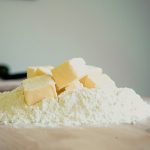Leavening is a crucial process in baking that involves the production of gases within dough, causing it to expand and resulting in the light, airy texture characteristic of many baked goods. Traditionally, this has been achieved through biological means (yeast) or chemical leavening agents (baking powder and baking soda). However, an emerging technique, electrochemical leavening, offers a novel approach by generating gases directly within the dough using electric currents. This method has the potential to revolutionize baking by providing a controlled, efficient, and potentially healthier way to achieve leavening. Unfortunately it is not that well described in the research literature so remains rather sketchy as a technology.
The Science of Traditional Leavening
Traditional leavening methods rely on biological or chemical reactions to produce gases:
- Biological Leavening: Yeast ferments sugars in the dough, producing carbon dioxide (CO₂) and ethanol. The CO₂ gets trapped in the dough’s gluten network, causing it to rise.
- Chemical Leavening: Baking soda (sodium bicarbonate) reacts with an acid, or baking powder (a mixture of baking soda and acid) reacts with moisture, releasing CO₂ gas.
Both methods depend on specific ingredients and conditions, such as the presence of fermentable sugars, appropriate temperature, and pH levels, to produce the necessary gases.
Electrochemical Leavening: Concept and Mechanism
Electrochemical leavening bypasses these traditional requirements by using an electric current to generate gases directly within the dough. This method involves the following steps:
- Electrodes and Electrical Setup: Electrodes are immersed in the dough, and a low voltage is applied across them. The electrodes are typically made of inert materials such as platinum or graphite to prevent any unwanted chemical reactions with the dough components.
- Electrolysis of Water: The electric current causes the electrolysis of water present in the dough. The basic electrochemical reactions at the electrodes are:
- At the cathode (negative electrode): 2+2e−→H2+2OH−2H₂O + 2e⁻ → H₂ + 2OH⁻
- At the anode (positive electrode): 2H2O→O2+4H++4e−2H₂O → O₂ + 4H⁺ + 4e⁻
These reactions produce hydrogen (H₂) and oxygen (O₂) gases. The gases are distributed throughout the dough, causing it to expand and rise.
- Control and Efficiency: The amount of gas produced can be precisely controlled by adjusting the voltage and the duration of the electrolysis process. This level of control is a significant advantage over traditional leavening methods, where gas production can be less predictable and more dependent on external conditions.
Advantages of Electrochemical Leavening
- Precision and Control: The ability to control gas production with precision allows bakers to achieve consistent results. By adjusting the voltage and time, the exact amount of gas needed for optimal leavening can be generated, reducing the variability associated with biological or chemical leavening agents.
- No Chemical Additives: Electrochemical leavening eliminates the need for chemical leavening agents like baking powder or baking soda. This can be particularly beneficial for consumers seeking cleaner labels and fewer additives in their food.
- Versatility: This method can be applied to a wide range of doughs, including those with low or no sugar content, where traditional yeast-based leavening might be ineffective. It also opens up possibilities for gluten-free and other specialty dough formulations that may not leaven well with traditional methods.
- Environmental Impact: By reducing the reliance on chemical leavening agents, which require industrial production and packaging, electrochemical leavening can potentially lower the environmental footprint of baking. Additionally, the method’s energy requirements are relatively low, contributing to overall energy efficiency.
Challenges and Considerations
While electrochemical leavening offers many advantages, several challenges and considerations need to be addressed:
- Equipment and Cost: The initial setup for electrochemical leavening requires specialized equipment, including electrodes and power sources. The cost and complexity of this equipment might be a barrier for small-scale or traditional bakeries.
- Safety and Food Quality: Ensuring that the materials used for electrodes are food-safe and do not contaminate the dough is crucial. Additionally, the method must be carefully controlled to avoid overproduction of gases, which could negatively impact the texture and quality of the final product.
- Consumer Acceptance: As with any new technology, consumer acceptance can be a hurdle. Educating consumers about the benefits and safety of electrochemical leavening is essential for its widespread adoption.
- Regulatory Approval: Any new food production method must undergo rigorous testing and approval by food safety authorities. Electrochemical leavening would need to meet all regulatory requirements to be accepted in the commercial food industry.
Practical Applications and Future Directions
Electrochemical leavening holds promise for a variety of baking applications:
- Artisanal and Specialty Breads: Bakers can achieve precise control over the leavening process, producing artisanal breads with specific textures and characteristics. This method is particularly useful for breads that require consistent quality and appearance.
- Gluten-Free Products: Gluten-free doughs often struggle to achieve the same rise and texture as traditional wheat-based doughs. Electrochemical leavening can help improve the quality of gluten-free baked goods by providing a reliable leavening mechanism.
- Reduced Additive Products: With growing consumer demand for products with fewer additives, electrochemical leavening can produce baked goods without the need for chemical leavening agents, aligning with clean label trends.
- Innovation in Baking Techniques: The technology opens up new possibilities for innovation in baking. Experimentation with different dough compositions and leavening parameters could lead to novel baked products with unique textures and flavors.
Electrochemical leavening represents a significant advancement in baking technology, offering precise control over gas production and eliminating the need for chemical leavening agents. While there are challenges to overcome, including equipment costs, safety considerations, and regulatory approval, the potential benefits make it a promising alternative to traditional leavening methods. As the baking industry continues to evolve, electrochemical leavening could play a crucial role in developing new, high-quality baked goods that meet the demands of modern consumers. The integration of this innovative method into commercial baking processes could revolutionize the way we think about and produce leavened products


Leave a Reply